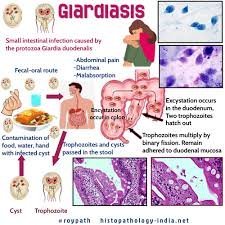The Best Foods to Eat When You Have Giardiasis
Giardiasis, caused by the parasite Giardia lamblia, can wreak havoc on your digestive system, leading to diarrhea, abdominal cramps, nausea, and dehydration.

Giardiasis, caused by the parasite Giardia lamblia, can wreak havoc on your digestive system, leading to diarrhea, abdominal cramps, nausea, and dehydration. Managing your diet while undergoing treatment is crucial for alleviating symptoms, promoting recovery, and maintaining hydration.
This guide outlines the best foods to eat when you have giardiasis, with an emphasis on easily digestible, nutrient-rich options to support your recovery. Additionally, the role of medications like nitazoxanide tablets in treatment will be discussed briefly.
1. Focus on Hydration
Dehydration is one of the most pressing concerns during giardiasis. Replenishing lost fluids is essential
Water
Sip water throughout the day to avoid dehydration. Opt for purified or boiled water to prevent further exposure to contaminants.
Oral Rehydration Solutions (ORS)
These solutions, available at most pharmacies, can help replace lost electrolytes and fluids.
Clear Broths
Chicken or vegetable broths are excellent for hydration and provide some nutrients without overwhelming your digestive system.
Herbal Teas
Non-caffeinated options like chamomile or peppermint tea can soothe the stomach and help with digestion.
2. Low-Fat Foods
Fatty foods can be hard to digest, especially when the digestive system is compromised. Stick to low-fat options such as
Lean Proteins
Skinless chicken, turkey, or white fish are gentle on the stomach and provide essential protein for healing.
Egg Whites
Avoid the yolks initially if they cause discomfort, as they are higher in fat.
Tofu: A plant-based, low-fat protein source that is easy to digest.
3. Incorporate Easily Digestible Carbohydrates
Carbohydrates are a good source of quick energy. Opt for easily digestible, bland carbohydrates, such as
Rice
White rice is preferred over brown rice as it is less fibrous and easier on the stomach.
Potatoes
Boiled or mashed potatoes without added butter or cream are soothing.
Plain Crackers or Toast
These can help settle an upset stomach.
4. Probiotic-Rich Foods
Probiotics are beneficial bacteria that support gut health and can help restore balance to your digestive system after a giardiasis infection. Include
Yogurt
Choose plain, unsweetened yogurt with live cultures to aid digestion and replenish good bacteria.
Kefir
A fermented milk drink that is rich in probiotics and easier to digest for those who are lactose-intolerant.
Fermented Vegetables
Small amounts of sauerkraut or kimchi can support gut health, but avoid overly spicy versions.
5. Non-Irritating Fruits and Vegetables
Certain fruits and vegetables are gentle on the stomach while providing essential vitamins and minerals
Bananas
High in potassium, bananas are great for replacing lost electrolytes and are easy to digest.
Applesauce
Choose unsweetened varieties for a gentle source of nutrients.
Carrots and Zucchini
These vegetables, when cooked until soft, are easy to digest and provide essential vitamins.
Pumpkin
A soothing and nutrient-rich option that is gentle on the stomach.
6. Avoid Trigger Foods
To minimize irritation and prevent worsening of symptoms, avoid the following:
Dairy Products
Except for probiotic-rich options like yogurt, as lactose intolerance can develop during giardiasis.
High-Fiber Foods
Whole grains, raw vegetables, and legumes may be too harsh on the digestive system initially.
Fried and Greasy Foods
These can exacerbate diarrhea and abdominal discomfort.
Spicy Foods
Spices can irritate the digestive tract, so avoid them during recovery.
Caffeinated and Alcoholic Beverages
These can dehydrate the body and irritate the stomach lining.
7. Role of Nitazoxanide Tablets in Treatment
Nitazoxanide is an antiparasitic medication commonly prescribed to treat giardiasis. This tablet is effective in eliminating Giardia lamblia and is typically taken twice daily with food to enhance absorption and reduce gastrointestinal side effects. While nitazoxanide tablets are highly effective, they should always be taken as directed by a healthcare professional to ensure complete eradication of the parasite.
8. Sample Meal Plan for Giardiasis Recovery
Here is a simple meal plan tailored to ease symptoms and support recovery.
Breakfast
A bowl of plain yogurt with a sliced banana and a slice of dry toast.
Mid-Morning Snack
Applesauce or a small serving of kefir.
Lunch
Boiled white rice with steamed carrots and skinless chicken breast.
Afternoon Snack
Plain crackers and chamomile tea.
Dinner
Mashed potatoes with baked white fish and steamed zucchini.
Evening Snack
A small serving of pumpkin puree or a probiotic-rich smoothie made with kefir.
9. Long-Term Dietary Adjustments
Even after the infection is resolved, your digestive system may remain sensitive for a while. Gradually reintroduce higher-fiber and more complex foods to your diet. Continue to prioritize hydration and consider adding probiotics to your routine to maintain gut health.
Conclusion
Managing your diet during giardiasis is crucial for symptom relief and recovery. Focus on hydration, low-fat and easily digestible foods, and avoid irritants to your digestive system. Probiotic-rich options can help restore gut balance. Nitazoxanide tablets play a critical role in treating the infection, and following dietary recommendations alongside this treatment can optimize your recovery. Always consult your healthcare provider for personalized advice and guidance during your treatment journey.
What's Your Reaction?














